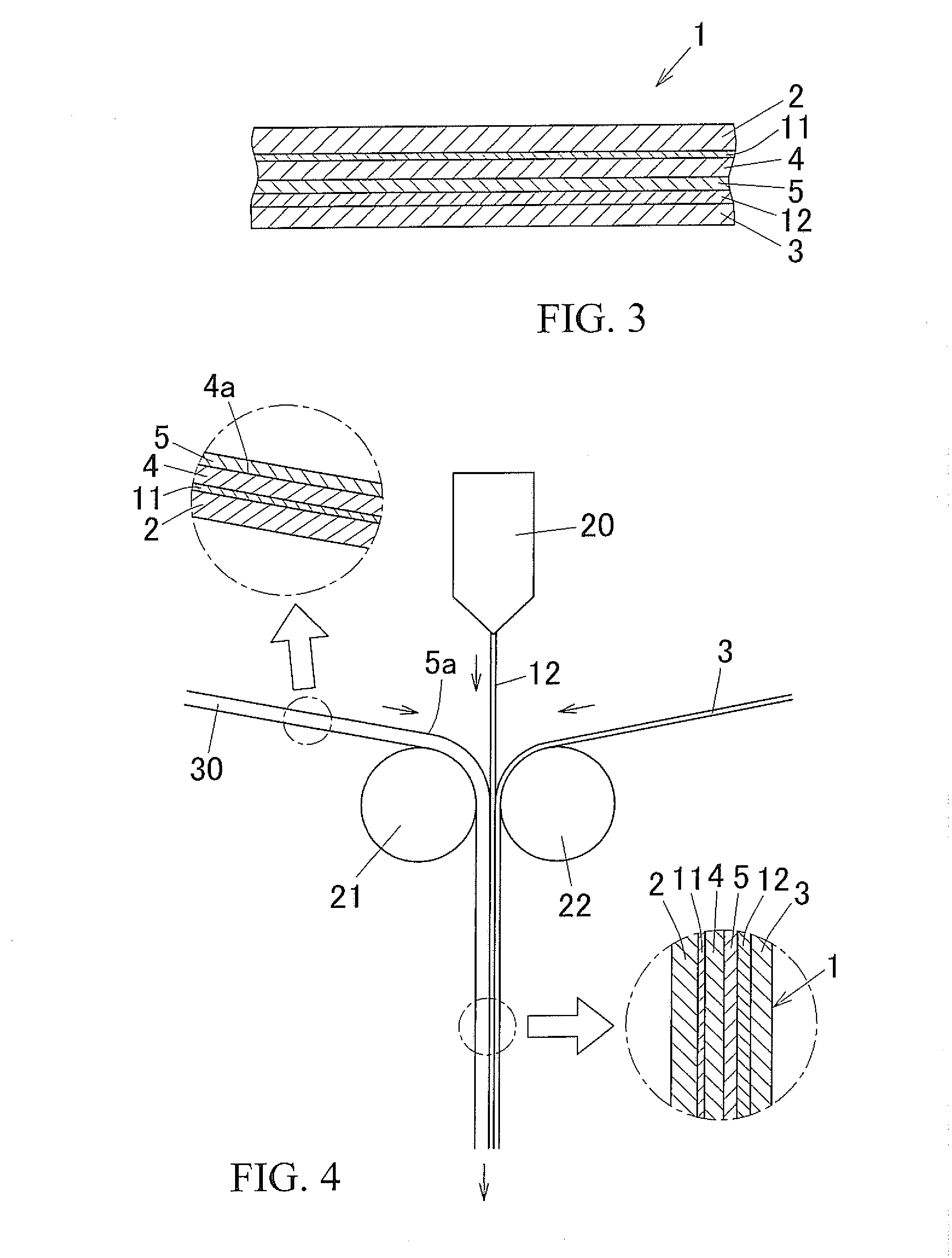Molding packaging material and method for producing same
a packaging material and mold technology, applied in the field of packaging materials, can solve the problems of battery performance deterioration or leakage, and achieve the effects of preventing deterioration of interlaminar strength, and ensuring interlaminar strength
- Summary
- Abstract
- Description
- Claims
- Application Information
AI Technical Summary
Benefits of technology
Problems solved by technology
Method used
Image
Examples
synthetic example 1
Polypropylene Resin J Containing a Carboxyl Group
[0115]Using a twin screw extruder in which the maximum temperature of the cylinder part was set to 170° C., 100 mass parts of a propylene-ethylene random copolymer (MFR: 10 g / 10 min, melting point: 85° C.; hereinafter referred to as “propylene-based random copolymer A”) made of 97 mol % of propylene unit and 3 mol % of ethylene unit produced using a metallocene catalyst as a polymerization catalyst, 2 mass parts of maleic anhydride, 1 mass part of lauryl methacrylate, and 1.5 mass parts of di-t-butyl peroxide were mixed and reacted. Afterward, the mixture was degassed in the extruder under reduced pressure, and the remaining unreacted material was removed to synthesize a polypropylene resin J containing a carboxyl group (B component.) In the polypropylene resin J containing a carboxyl group, the MFR measured at 130° C. was 12 g / 10 min, and the content of the carboxyl group was 0.4 mmol for 1 g of the polypropylene resin (resin J) cont...
synthetic example 2
Polypropylene Resin K Containing a Carboxyl Group
[0116]A polypropylene resin K containing a carboxyl group (B component) was synthesized in the same manner as in Synthetic Example 1 except that a propylene-ethylene random copolymer B (MFR: 5 g / 10 min) made of 97 mol % of propylene unit and 3 mol % of ethylene unit produced using a metallocene catalyst as a polymerization catalyst was used instead of the propylene-based random copolymer A. In the polypropylene resin K having a carboxyl group, the MFR measured at 130° C. was 8 g / 10 min, and the content of the carboxyl group was 0.4 mmol for 1 g of the polypropylene resin (resin K) containing a carboxyl group.
synthetic example 3
Polypropylene Resin L Containing a Carboxyl Group
[0117]A polypropylene resin L containing a carboxyl group (B component) was synthesized in the same manner as in Synthetic Example 1 except that a propylene-ethylene random copolymer C (MFR: 36 g / 10 min) made of 97 mol % of propylene unit and 3 mol % of ethylene unit produced using a metallocene catalyst as a polymerization catalyst was used instead of the propylene-based random copolymer A. In the polypropylene resin L containing a carboxyl group, the MFR measured at 130° C. was 40 g / 10 min, and the content of the carboxyl group was 0.4 mmol for 1 g of the polypropylene resin (resin K) containing a carboxyl group.
PUM
| Property | Measurement | Unit |
|---|---|---|
| Temperature | aaaaa | aaaaa |
| Temperature | aaaaa | aaaaa |
| Temperature | aaaaa | aaaaa |
Abstract
Description
Claims
Application Information
 Login to View More
Login to View More - R&D
- Intellectual Property
- Life Sciences
- Materials
- Tech Scout
- Unparalleled Data Quality
- Higher Quality Content
- 60% Fewer Hallucinations
Browse by: Latest US Patents, China's latest patents, Technical Efficacy Thesaurus, Application Domain, Technology Topic, Popular Technical Reports.
© 2025 PatSnap. All rights reserved.Legal|Privacy policy|Modern Slavery Act Transparency Statement|Sitemap|About US| Contact US: help@patsnap.com



